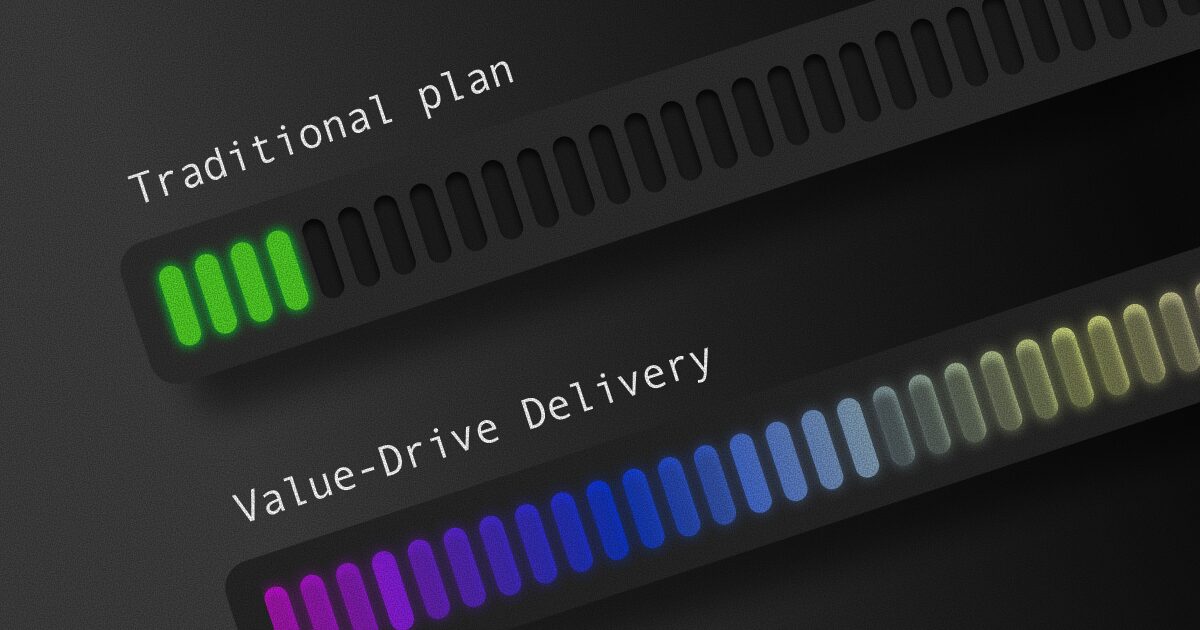February 24, 2025 - 7 min
Mastering Mobile App Development Project Management: How to Outperform Your Competition

How many minutes has it passed since you opened one of the apps on your phone? Mobile apps have become essential tools in our day-to-day life. From food delivery, news or fintech apps, these software products dominate almost every aspect of our day. But the development of a successful mobile app takes time, dedication, and a whole lot of expertise. Well planned mobile app development project management principles serve as the foundation to delivering high quality apps that meet deadlines as well as budget constraints. This is why we wrote a blog post to show you the crucial role of project management in creating and delivering high-performing mobile apps.
Core Principles of Mobile App Project Management
Clear Objectives & Clear Scope
Every project should start with a well-defined goal and a clear scope. Mobile app development is not an exception to this rule. Document main business objectives, and core functionalities, prioritise requirements and define success metrics.
Ask your client what a project success looks like for them. Integrate and remember this vision throughout your discovery process.
Agile Development
Agile development approach will ensure flexibility and adaptability given the fast-changing nature of mobile technology. Think about client feedback and how it needs to be continuously integrated to refine your product. This would be very hard if you are not failing fast and learning fast.
User-Centric Approach
Any team member in your project uses various mobile applications in their day-to-day life. We all notice when user experience is not on point, we get frustrated, and maybe even cancel subscriptions. Think about these things when setting up your project. User experience (UX) is one of the ground rules for successful mobile app development.
Efficient project management ensures that UX designers, developers, and QAs collaborate to prioritise user-friendly interfaces, seamless navigation, and top-quality user experience.
Cross-Platform Compatibility
Mobile applications must function across different operating systems (iOS and Android) and on various devices. This directly impacts project planning and release times. As a project manager, ensure optimal testing timeframes and include compatibility checks within the project schedule.
Security & Compliance
Three words here. Security, security and again, security. With the increasing number of cyber threats and data privacy regulations, application security and regulatory compliance is a must.

Development Lifecycle of a Mobile App
1) Project Initiation
In this initial phase, the project’s objectives are defined. This includes:
- determining the scope of the project
- listing all the functionalities that need to be developed
- identifying the target platforms (Android, iOS, or both)
- deciding on the technologies to be used for development (Native Android/iOS or cross-platform technologies like Flutter)
2) Design
After establishing the scope and required functionalities, the design phase begins, focusing on determining the overall user experience of the app and creating the app’s visual appearance while complying with established mobile app design principles and platform-specific guidelines (Android and iOS).
3) Development & Testing
The development phase involves several key steps:
- setting up the project using the agreed-upon technology (with separate setups for each platform in the case of native iOS and Android development)
- creating a Git repository for version control
- preparing different environments (development, staging, production)
- connecting the app to a crash analytics tool
- establishing a Continuous Integration/Continuous Delivery (CI/CD) process
- implementing design settings from the app design (colors, themes, text styles, paddings, etc.)
- eginning the development of reusable UI components
Following these initial steps, the team proceeds with feature development according to agreed-upon plans and sprint schedules. As a standard procedure, unit tests are written to validate the behaviour of code units and code reviews are conducted to ensure code quality, consistency and compliance with standards.
Typically, at the end of each two-week sprint, there are demo presentations to the client and app distribution for testing (via Testflight for iOS, Google Play for Android).
The testing is done by the QA, after features within each Sprint are implemented.
4) Release & Ongoing Activities
After implementing and testing the agreed-upon set of features, the app is prepared for release to the app stores. This involves setting up the necessary information on the Apple App Store and Google Play Store (app name, description, screenshots, data privacy details, etc.) to be able to release the initial version of the app.
Depending on the client agreement, the following activities may occur:
- continuing development with new features and releasing updated versions of the app
- handing over the project to the client and ending the collaboration
- continuing the collaboration through maintenance, focusing on bug fixes, improvements to existing features, and potentially adding minor new functionalities, rather than intensive development of major new features
Key Challenges in Mobile App Project Management
Despite structured planning and as in any project, it’s common we usually find some common challenges such as:
- rapid technological changes: frequent updates in mobile OS, frameworks, and security protocols necessitate a flexible project strategy
- device and platform fragmentation: managing development for different platforms and a vast array of devices can lead to compatibility and performance issues
- uncertain user expectations: user preferences evolve quickly, which makes it challenging to prioritise the app features
- continuous maintenance needs: unlike traditional software, mobile apps require frequent updates, bug fixes, and new feature rollouts to maintain user engagement.
Which Tools & Technologies to Use to Streamline the Process?
Mobile app development tools include a variety of frameworks, libraries and environments essential for developers to efficiently build, test, and deploy applications. Using the right tools can significantly accelerate and improve the mobile app development process.
In the majority of cases (90-95%) when aiming to speed up mobile app development for both iOS and Android, a cross-platform solution proves to be a more efficient choice than a native approach, which necessitates separate development for each platform.
In this area, Flutter and React Native stand out as the top choices. Other cross-platform solutions tend to lag behind, taking into account the current maturity of the platforms, either in terms of performance, widespread usage or community support.
The following mobile app development tools are used in both native and cross-platform development:
- Xcode: the integrated development environment (IDE) used for developing native iOS applications
- Android Studio: this is the most popular IDE for creating native Android applications that can also support the extension installation when using the Flutter kit for development
- VSCode: a ‘lightweight’ multi-purpose IDE that can be used for developing various types of applications with different technologies. In addition, it can easily become your smart assistant in developing React Native or Flutter projects; provided if you install the required extensions such as GitLens, ESLint, React Native Snippet, etc.
Continuous Integration and Continuous Delivery (CI/CD) tools: these are software solutions that help automate the process of building, testing, and making changes or refinements in your code.
These tools streamline the release process, reduce the likelihood of failure at deployment and provide a consistent build environment across all environments. At our company, we use Bitrise as the tool of choice. However, there are several other great performing options with the same function — these are CodeMagic, Jenkins and GitHub Actions.
Once the app is ready to be tested by the Quality Assurance team and the client, this is usually done with TestFlight for iOS and Google Play internal testing channel for Android operating system.

Different Project Management Methodologies & Best Practices
Here’s a list of the most common methodologies used in mobile app development project management:
- Agile (Scrum/Kanban): this methodology helps simplify quick iterations and provides frequent feedback from users
- Waterfall: often used for the initial planning and documentation of the project
- DevOps: it guarantees the implementation of the CI/CD pipeline for a more optimised deployment process
- Lean startup: this methodology assists in building the minimum viable product (MVP) and iterating on it based on the app users’ insights
Taking into account the methodologies above, a hybrid approach that includes different practices and methodologies is the best way to increase your overall project management efficiency.
Using a hybrid approach, Q has upgraded both the web and mobile app for our loyal partner, WaterBear. This is a platform for environmentally themed videos and content that brings their audience to concrete actions.
Here’s a brief overview of what we did for our client:
- enhancement of the Home feed with personalised articles, events, videos and missions
- improved search and filtering functions
- enhanced community interaction by promoting awareness and encouraging participation in social and environmental causes
More on our client’s mission and how we approached this project, you can learn more in this link.
What the Future Holds for Mobile App Project Management
With the fast changes in technology happening before our eyes, user expectations also change. This is why the future trends should be an absolute must in the practice of mobile app development — AI-powered development, low-code development, automated testing, etc. are going to bring even more innovation and be crucial for success in future mobile app development projects.
- AI-driven development: AI is improving the efficiency in delivery timelines greatly. The role of developers is shifting from writing the code to a role of supervisor of sorts. From being those who code to overseeing and supervising AI tools that will do the coding instead
- low-code/no-code development: this next-generation type of building software speeds up app development and decreases the need for complicated coding, providing a great alternative for creating less complex apps which often require faster launch
- remote & hybrid workflows: cloud-based collaboration tools allow for the seamless execution of your projects
- automated testing: integration of AI-powered tools inevitably speeds up and ensures better quality code delivery before the final user testing
Conclusion
In this blog post, we covered the mobile app development lifecycle, development-related key challenges, as well as project management methodologies and tools that help manage projects like these. If you want to make sure to provide your services such as building a high-quality mobile app in a very competitive environment that reigns nowadays, first things first is setting up a robust project management strategy. A well thought out PM strategy is the core of efficient and successful project management in mobile app development. Or any app for that matter.
And let’s not forget the fact that for the software development sector, the future holds many challenges, but it will be no short of opportunities either. Be it the low-code and no-code platforms, AI-driven development or automated testing — it’s essential for both developers and project managers to always keep up with this fast-changing industry. Or even better, be one step ahead of your competition at all times.
If you’d like to do business with us, you’re more than welcome to get in touch and start working together on next-gen software. We are ready.
Give Kudos by sharing the post!






